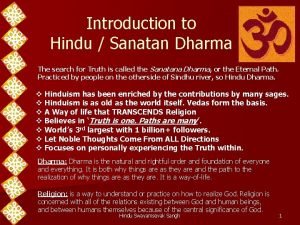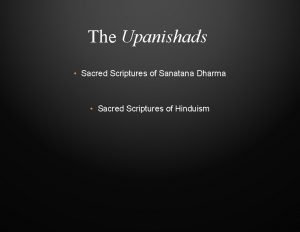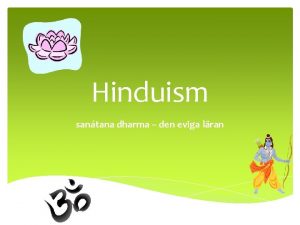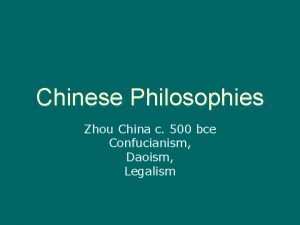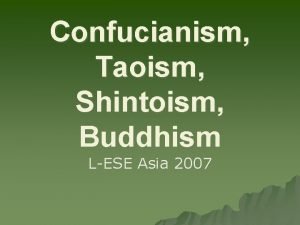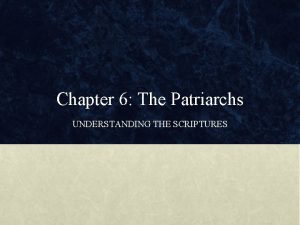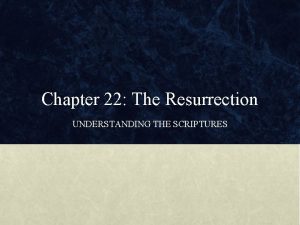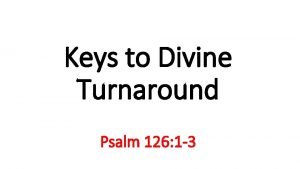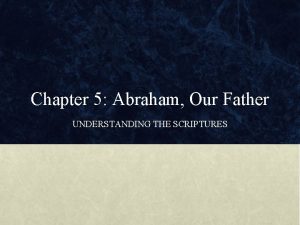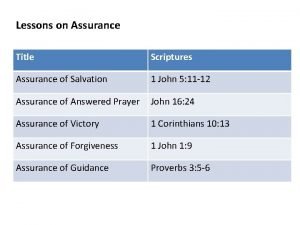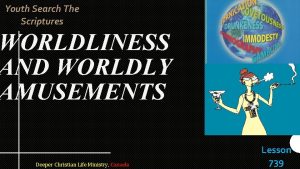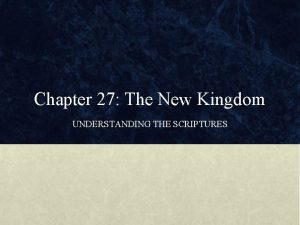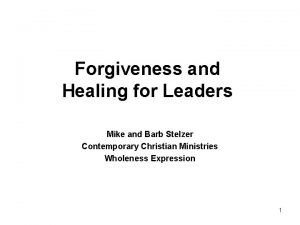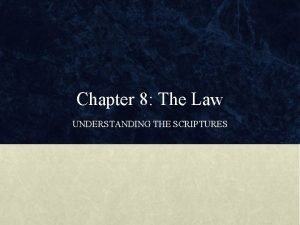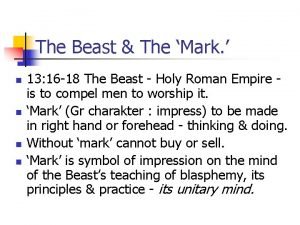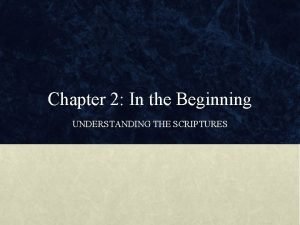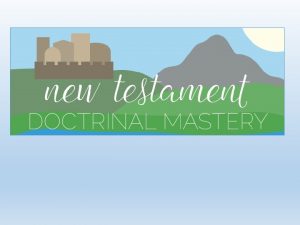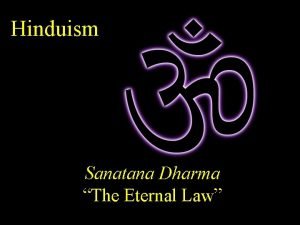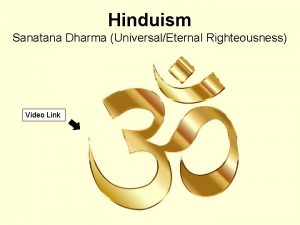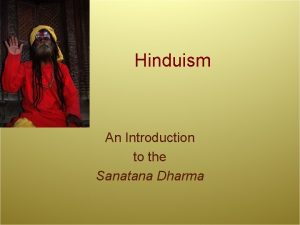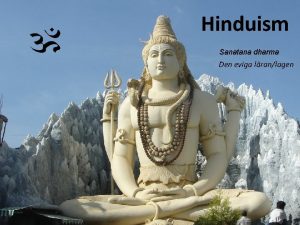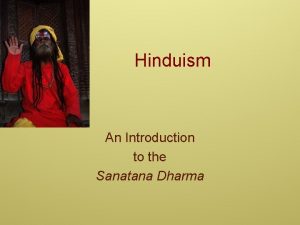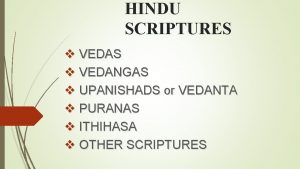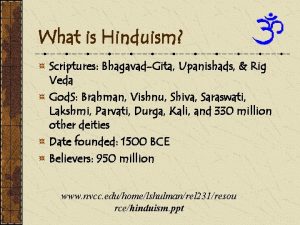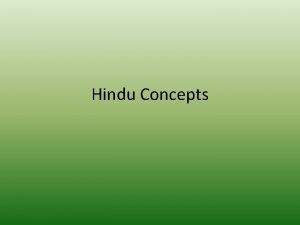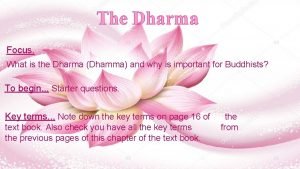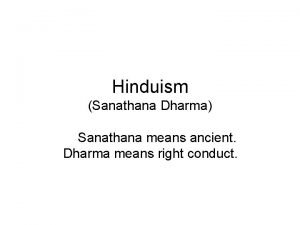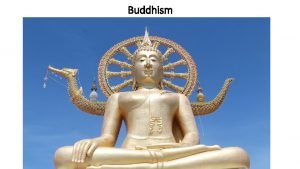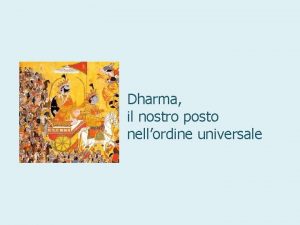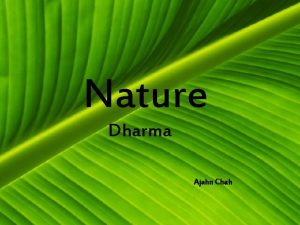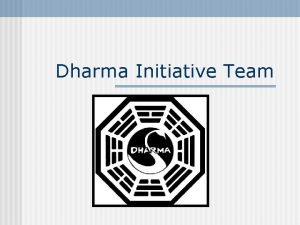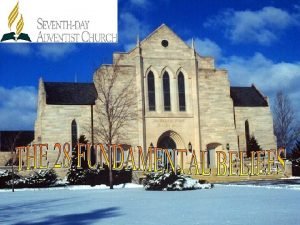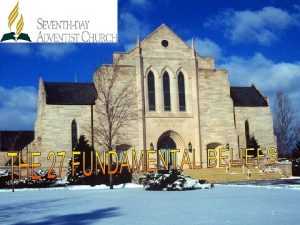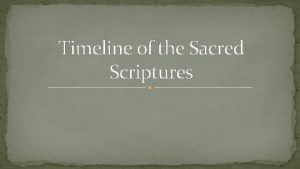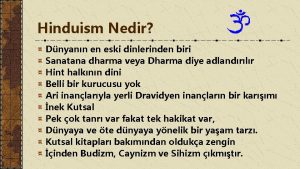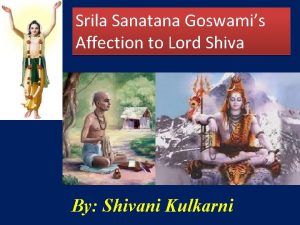The Upanishads Sacred Scriptures of Sanatana Dharma Sacred

























![Tat Tvam Asi “Thou [Atman] art That [Brahman]” (Chandogya Upanishad, VI) There is a Tat Tvam Asi “Thou [Atman] art That [Brahman]” (Chandogya Upanishad, VI) There is a](https://slidetodoc.com/presentation_image_h/e8100dc0b7f2ffd1b6075e8e910d97f6/image-26.jpg)








![“By the mind alone is It [Brahman] to be perceived. There is on earth “By the mind alone is It [Brahman] to be perceived. There is on earth](https://slidetodoc.com/presentation_image_h/e8100dc0b7f2ffd1b6075e8e910d97f6/image-35.jpg)











- Slides: 46

The Upanishads • Sacred Scriptures of Sanatana Dharma • Sacred Scriptures of Hinduism

Upanishad Upa- (near), ni- (down), sad (to sit): sitting near the teacher

Composed by various seers and sages between 800 -500 BCE, the Upanishads are a culmination and completion of an earlier body of Hindu sacred texts called the Vedas. Veda = knowledge Upanishads are Vedanta: End of the Vedas

The Teachings of the Upanishads

Six Key Concepts in the Upanishads Atman Brahman Avidya Karma Samsara Moksha

I. BRAHMAN

The Upanishads emphasize the imper manence of the empirical world, physical reality as we experience it through our senses. Maya

The Upanishads distinguish between the changing, transient nature of the empirical universe and a single ultimate tr anscendent r eality that is unchanging and permanent.

Brahman Ultimate Cosmic Reality

The distinction between Maya and Brahman allows Upanishadic thinkers to affirm the unity or oneness of all things. All that is is Brahman. Reality is ultimately one and unchanging, though it appears as many and changing.

Brahman Alone is Real. Everything Else is Illusion.

What more can be said about the nature of Brahman?

We can speak of Brahman as “being” (sat), “consciousness” (cit), and “bliss” (ananda). However, these are merely ways of talking about the human apprehension of Brahman.

In itself Brahman cannot be defined or positively described. Ultimately “Brahman” is a way of designating a state in which subject-object duality ceases to exist. “There is no better description [of Brahman] than this: that it is not-this, it is not-that (neti, neti). ” Brhad-aranyaka Upanishad, II, 3, 6.

Dual Aspect Theism Nirguna Brahman in itself is beyond all human categories and conceptualization. In itself Brahman has no attributes. Saguna Brahman in relation to maya and as an object of human discourse and devotion, with attributes.

Implications?

In itself the Supreme being cannot be known, as the Infinite surpasses or transcends all human conception. The impersonal Supreme being is made personal through manifestations of the Infinite in finite form.

The many gods of Hinduism represent different aspects of one and the same ultimate reality, Brahman. Brahma Vishnu Shiva Hinduism views the cosmic activity of the Supreme Being as comprised of three tasks: creation, preservation, and dissolution and recreation. Three deities (Trimurti) represent these tasks: Brahma, Vishnu, and Shiva.

II. ATMAN

The True Self (Atman) The Upanishads teach the existence of a true Self called Atman. The individual personality, soul, or self (jiva) belongs to the realm of maya (illusion that something is permanent). The jiva is conditioned by Atman is timeless, spaceless, unchanging pure consciousness, only temporarily manifested as jiva in maya.

Relation between Atman and Jiva

“The wise one is not born, nor dies. This one has not come from anywhere, has not become anyone. Unborn, constant, eternal, primeval, this one Is not slain when the body is slain. . He who is the bodiless among bodies, Stable among the unstable. The great, all pervading Self – On recognizing Him, the wise man sorrows not. ” Kena Upanishad II. 18, 22

“That Self (Atman) is not this, it is not that (neti, neti). It is unseizable, for it cannot be seized; indestructible, for it cannot be destroyed; unattached, for it does not attach itself; is unbound, does not tremble, is not injured. ” Brhadaranyaka Upanishad, iv. v. 15

Relation between Brahman and Atman

Atman is Brahman
![Tat Tvam Asi Thou Atman art That Brahman Chandogya Upanishad VI There is a Tat Tvam Asi “Thou [Atman] art That [Brahman]” (Chandogya Upanishad, VI) There is a](https://slidetodoc.com/presentation_image_h/e8100dc0b7f2ffd1b6075e8e910d97f6/image-26.jpg)
Tat Tvam Asi “Thou [Atman] art That [Brahman]” (Chandogya Upanishad, VI) There is a common consciousness between Atman and Brahman. “The individual self, apart from all factors that differentiate it from pure consciousness, is the same as the divine, apart from its differentiating conditions. ” (Eliot Deutsch, Advaita Vedanta, p. 50)

Strip away all appearances and every self is identical with the ultimate reality.

III. AVIDYA and VIDYA

The human perspective is characterized by ignorance (avidya) of the true nature of reality and the self.

Analogy A rope may appear to be a snake. Likewise, the universe may appear to be many and changing, and we may appear to be individuals within the universe. This is appearance only, grounded in avidya.

IV. SAMSARA and KARMA

Avidya Egoism Ignorance leads to egocentric desires Egoism New Physical Forms Our egocentric desires and actions create and perpetuate new physical forms or vehicles for atman.

From this set of Upanishadic teachings emerges the doctrine of Reincarnation or Rebirth. Humans live multiple embodied lives, experiencing a cyclical process of birth, death, and rebirth (samsara).

“Where one’s mind is attached – the inner self Goes thereto with action, being attached to it alone. Obtaining the end of his action, Whatever he does in this world, He comes again from that world To this world of action. - So the man who desires. ” Brhadaranyaka Upanishad, iv. 6
![By the mind alone is It Brahman to be perceived There is on earth “By the mind alone is It [Brahman] to be perceived. There is on earth](https://slidetodoc.com/presentation_image_h/e8100dc0b7f2ffd1b6075e8e910d97f6/image-35.jpg)
“By the mind alone is It [Brahman] to be perceived. There is on earth no diversity. He gets death after death, Who perceives here seeming diversity. ” Brhadaranyaka Upanishad, iv. 19

Samsara and Suffering Human suffering – lack of satisfaction in life - is associated with material forms of existence. As long as samsara continues a person is doomed to experience suffering.

Rebirth is governed by karma (literally “action”). In the Upanishads karma designates a law of cosmic justice according to which every action has an effect that is proportioned to the moral quality of the action.

Karma includes the character one has formed through one’s choices and actions. Bad Karma Right Action Wrong Action Good Karma determines the nature of one’s future incarnations.

Rebirth is not desirable. It implies that a person is still trapped in ignorance about the nature of reality. Suffering, associated with material existence, has not yet been transcended.

VI. MOKSHA

The Ultimate State (Moksha) Suffering is transcended only by release from samsara and absorption into Brahman, the one ultimate reality. This is a state of knowledge, enlightenment, or absolute consciousness in which the true nature of reality (Brahman) and the true self (Atman) is perceived.

It is also a state of freedom (moksha). The only thing that can be free is that which is one, for only that which is one has no desire. Being all that there is, there is nothing else for it to desire. There is nothing left to suffer.

“Now the man who does not desire – He who is without desire, who is freed from desire, whose desire is satisfied, whose desire is the Self (atman) – his breath does not depart. Being very Brahman, he goes to Brahman. ” Brhadaranyaka Upanishad, iv. 6

“As the flowing rivers in the ocean Disappear, quitting name and form, So the knower, being liberated from name and form, Goes unto the Heavenly Person, higher than the high. He, verily, who knows the Supreme Brahman, becomes Brahman. ” Mundaka Upanishad, III. ii 8 -9

The ultimate goal is moksha or to be free from desire and the cycle of death and rebirth.

Six Key Concepts in the Upanishads Atman Brahman Avidya Karma Samsara Moksha
 Vad är sanatana dharma hinduism
Vad är sanatana dharma hinduism Hindu sanatan dharma
Hindu sanatan dharma Sanatana dharma principles
Sanatana dharma principles Helig veckodag hinduism
Helig veckodag hinduism Who is the main author of sacred scripture?
Who is the main author of sacred scripture? Sacred scripture of taoism
Sacred scripture of taoism Confucianism beliefs
Confucianism beliefs Dclm search the scriptures volume 77
Dclm search the scriptures volume 77 Understanding the scriptures chapter 6 study questions
Understanding the scriptures chapter 6 study questions Understanding the scriptures chapter 22 study questions
Understanding the scriptures chapter 22 study questions Divine turn around
Divine turn around Deeper life bible church netherlands search the scriptures
Deeper life bible church netherlands search the scriptures What the bible says about a pure heart
What the bible says about a pure heart Deeper life netherlands
Deeper life netherlands Search the scriptures netherlands
Search the scriptures netherlands Understanding the scriptures chapter 5 study questions
Understanding the scriptures chapter 5 study questions Dclm netherlands
Dclm netherlands Understanding the scriptures chapter 20 study questions
Understanding the scriptures chapter 20 study questions Scriptures to maintain deliverance
Scriptures to maintain deliverance Deeper life bible church netherlands search the scriptures
Deeper life bible church netherlands search the scriptures Assurance of salvation outline
Assurance of salvation outline Scriptures on worldliness
Scriptures on worldliness Dclm netherlands
Dclm netherlands Understanding the scriptures chapter 2 study questions
Understanding the scriptures chapter 2 study questions The deeper christian life
The deeper christian life Misquoted bible scriptures
Misquoted bible scriptures God's plan of salvation
God's plan of salvation Scriptures on forgiveness
Scriptures on forgiveness Grandchildren in hebrew
Grandchildren in hebrew Understanding the scriptures chapter 24 study questions
Understanding the scriptures chapter 24 study questions Search the scriptures netherlands
Search the scriptures netherlands Nn mark
Nn mark Understanding the scriptures chapter 2 study questions
Understanding the scriptures chapter 2 study questions Doctrinal mastery scriptures
Doctrinal mastery scriptures Search the scriptures netherlands
Search the scriptures netherlands Frameset trong html5
Frameset trong html5 Sơ đồ cơ thể người
Sơ đồ cơ thể người Thế nào là số nguyên tố
Thế nào là số nguyên tố Tia chieu sa te
Tia chieu sa te đặc điểm cơ thể của người tối cổ
đặc điểm cơ thể của người tối cổ Các châu lục và đại dương trên thế giới
Các châu lục và đại dương trên thế giới Chụp tư thế worms-breton
Chụp tư thế worms-breton ưu thế lai là gì
ưu thế lai là gì Tư thế ngồi viết
Tư thế ngồi viết Cái miệng bé xinh thế chỉ nói điều hay thôi
Cái miệng bé xinh thế chỉ nói điều hay thôi Mật thư anh em như thể tay chân
Mật thư anh em như thể tay chân Các châu lục và đại dương trên thế giới
Các châu lục và đại dương trên thế giới

